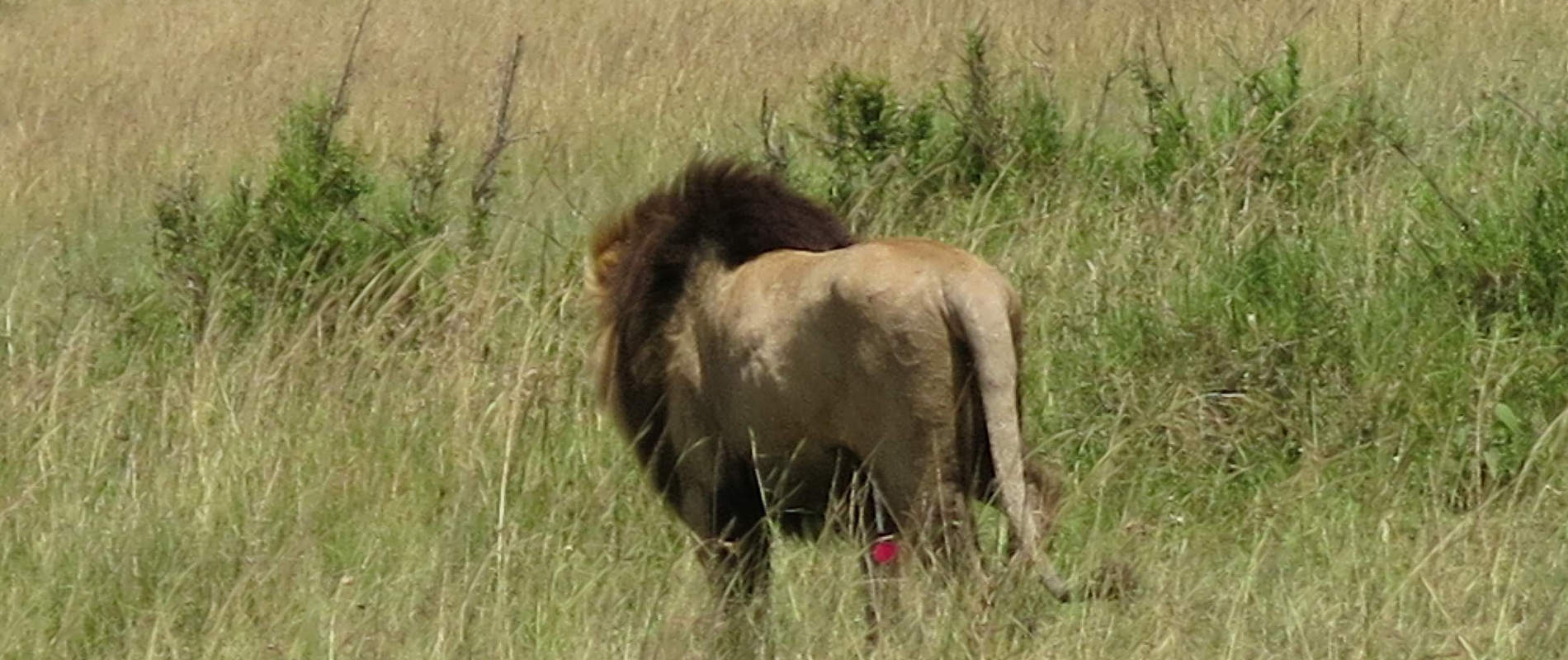FIELD VETERINARY REPORT FOR MASAI MARA-MAY 2016 By Dr
FIELD VETERINARY REPORT FOR MASAI MARA-MAY 2016
By Dr. Campaign .K. Limo
Introduction
Similar to previous months, the month of May was characterized by heavy precipitation. Many seasonal and permanent rivers were flooded with resultant hindrance to mobility. There is plenty for wildlife to utilize within and around the park with few human wildlife conflicts reported. As has been the case for the last few months since onset of rains, clinical interventions carried out were at all-time low.
The following are clinical interventions carried out during the month;
CASE#1 TREATMENT OF AN ELEPHANT WITH AN ARROW INJURY
Date: 8th May 2016
Species: African elephant
Sex: Female
Age: Adult
Location: Ngama Hills (Masai Mara National Reserve)
History
This adult female in a herd of about 20 elephants was seen walking with difficulty by tour guides on a morning game drive. They called the Mobile Veterinary Unit and the County Security Patrol Team for assessment and intervention.
She was found lagging behind the other members of the herd browsing lethargically and had lost condition. Her left front leg was swollen with a wound visible to the inner surface of her left arm near the elbow joint. Even with agitation, she was hesitant to move and when she tried she did so with a lot of difficulty and was obviously in a lot of pain.
Immobilization examination and treatment
Restraint was achieved chemically by use of 15mgs Etorphine hydrochloride delivered in a 1.5ml Dan inject dart from foot. It took seven minutes for the drugs to take full effect with the elephant assuming left lateral recumbency. She appeared to have been nursing as the teats were slightly engorged. The calf however, was not with her and was assumed to be among the rest of the herd.


Examination revealed a septic and maggot infested wound to the inner part of her left front limb near the elbow. Further probing revealed a barbed arrow head buried deep in the wound. The arrow head was gently retrieved, pus drained and maggots manually removed.
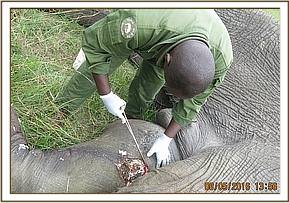

Additionally the debris was cleared with the help of hydrogen peroxide and gauze swabs. The wound was then rinsed with clean water, wiped dry with clean gauze swab and tincture of iodine applied. Green clay was then packed into the wound to absorb toxins and hasten healing. Additionally, she received 30000mgs Amoxicillin antibiotics and 4000mgs Flunixin Meglumine anti-inflammatory, all intramuscularly.
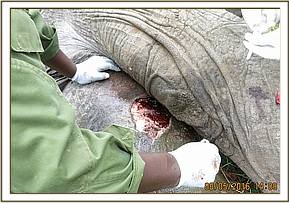

Reversal
The anaesthetic was reversed by use of 48mgs Diprenorphine Hydrochloride delivered intravenously through a prominent ear vein.
She had to be helped to rise up through pulling by use of ropes. She finally rose up and limped away.
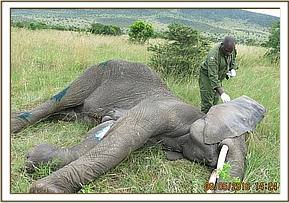

Prognosis
Good.
She was observed a day later having walked more than three kilometres. She appeared stronger and relieved. Eventual follow-up showed that she joined the rest of the herd and migrated from the area having drastically improved.
CASE#2: TREATMENT OF A WOUNDED LIONESS
Date: 15thMay 2016
Species: African lion
Age: Adult
Sex: Female
Location: Roan Hill (Masai Mara National Reserve)
History
This lioness nursing four, four month old cubs, was seen by Sala’s camp tour guides with some injuries. They called the Vet Unit for help and at the same time notified the reserve management who formed part of the team during intervention.
She was found in the company of another female thought to be her sister and four cubs which she was nursing. They were all under some small shrubs, sheltering from the sun. When agitated to stand, she did so with difficulty and several bite wounds to her right thigh and a deep wound between her hind legs were visible.
Immobilization, examination and treatment
Immobilization was achieved by use of a combination of 4mgs Medetomidine hydrochloride and 250mgs Ketamine hydrochloride delivered in a 3ml dan-inject dart from a vehicle. She became completely anaesthetised after eight minutes with the other female and the cubs running away to a nearby hideout when approached.
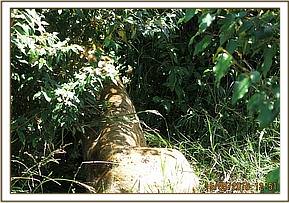

After making sure she was stable, examination revealed several bite wounds to her right thigh, and a deep one between her hind legs most likely inflicted by other lions after a fight. The deeper wound was bleeding and required some stitches after thoroughly debriding. Chromic catgut absorbable suture was used to stop the bleeding and to put in place subcutaneous suture to obliterate dead space. Tincture of iodine was then applied. The other wounds were wiped with sterile gauze swab and irrigated with tincture of iodine. Additionally Cloxacillin ointment was infused into all the wounds.
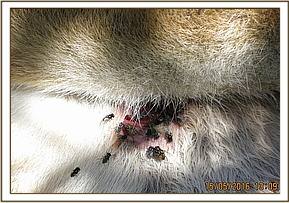

Other medications included administration of 3000mgs Amoxicillin antibiotic intramuscularly and 100mgs Ivermectin parasiticide subcutaneously.
Reversal
Reversal of anaesthetic was achieved by intramuscular administration of 15mgs Atepamezole hydrochloride one hour after immobilization.
She woke up after eight minutes and retreated deep into the shrubs. The cubs and the other female were guided by use of vehicles to join her.
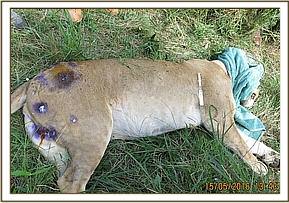

Prognosis
Good.
Sala’s camp tour guide report that she was seen three days later in good shape preparing to hunt.
CASE#3: RELOCATION OF A LIONESS FROM A CATTLE BOMA
Date: 18th May 2016
Species: African lion
Sex: Female
Age: Adult
Location: Talek
History
A call was made to the mobile veterinary unit by the Masai Mara National Reserve warden in charge of the Talek sector that a lioness was spotted having strayed into a cattle boma in the morning. The locals were threatening to kill her as it was a threat to the villagers and livestock that had already scampered out of the boma. This was an emergency and the unit responded quickly.
Capture and release
This lioness had taken refuge in a bushy part of the boma and was out of sight from everyone. The bush was thick.
After laying out strategy with all participating advising the villagers to get into their houses, the lioness was provoked to move out from the bush. The lioness dashed out upon where she was darted with a combination of 6mgs Medetomidine hydrochloride and 250mgs Ketamine hydrochloride in a 3ml dan-inject dart from foot in a safe location. She was fully anaesthetised in seven minutes and a blindfold was applied. She was treated for minor bruises obtained from squeezing herself through the fence.


She was loaded into the truck and taken back to the Reserve, to the relief of the villagers.
Reversal
Reversal of the anaesthetic was achieved by administration of 15mgs Atepamezole hydrochloride one hour after immobilization upon release at the reserve. She woke up after eight minutes and walked away to freedom.
CASE#4: INJURED LION
Date: 19th May 2016
Species: African lion
Sex: Male
Age: Adult
Location: Mara Triangle Conservancy
History
This famous lion, part of the Marsh pride and named Scar face, was seen in the morning by Mara Triangle rangers with a wound to the upper lateral side of his right eye.
This wound was a few inches from the previous scar which gave this famed lion the name Scar face. Scar face initially stayed in the Musiara area but of late has extended his territory to Mara Triangle but occasionally crosses the river back to Musiara where many members of the Marsh pride reside. Scar face has been treated several times over the past years and is always nervous when approached by a darting vehicle.
Scar face was carefully observed from a distance undisturbed and there was clear need for treatment and closer examination of the right eye.
Immobilization, examination and treatment
Immobilization was achieved by use of a combination of 6mgs Medetomidine hydrochloride and 250mgs ketamine in a 3ml dan-inject dart. Though elusive, Scar face was trailed and finally darted when he tried to hide under a small thicket. Darting was done from a vehicle and it took eight minutes for him to get fully anaesthetized upon which a blind fold was put in place. He was in good body condition and appeared to have recently fed.


Examination revealed a fresh wound above his right eye lateral to the previous scar. This could have been inflicted from fights with other lions and extended by his scratching on the resultant healing wound. The original scar has fibrosed, narrowing the upper eyelid but hardly affecting his vision and eye function.
The new wound was cleaned with hydrogen peroxide soaked in a swab and wiped dry using clean gauze swab. Tincture of iodine was applied before cloxacillin ointment was infused. Both eyes were also given cloxacillin ointment infusion to avoid desiccation.
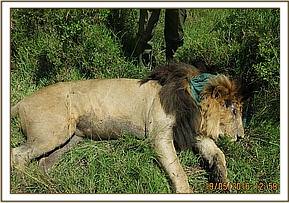

In addition, Scar face received parenteral administration of 3000mgs Amoxicillin antibiotic given intramuscularly and 30mgs Dexamethasone sodium anti- inflammatory given same route. He also received 100mgs Ivermectin parasiticide given subcutaneously.
Reversal
The anaesthetic was reversed by administration of 15mgs Atepamezole hydrochloride intramuscularly one hour after immobilization. He woke up within eight minutes and moved to a small thicket.
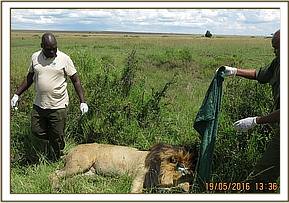

Prognosis
Good.
Other Activities
During the month, the mobile veterinary unit team visited conservancies within the Mara Ecosystem notably; Naboisho, Olare Motorogi, Olkinyei and Mara North for assessment of health status of the flagship species. Most of the animals were noted to be in good shape owing to abundance of food and water and less conflict with humans.
Conclusion
The Mara Mobile Veterinary Unit is grateful to all stakeholders who participated and contributed in one way or another to treatment and rescue of various wildlife species attended to during the period. Thanks to Minara Foundation through DSWT for their continuous facilitation and KWS management for the technical support and advice to the unit. Without all of you it would not be easy for the unit to achieve all these.
